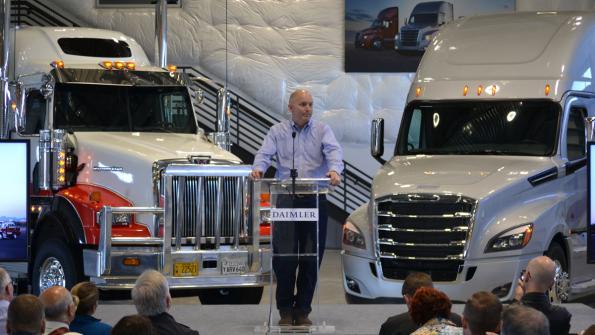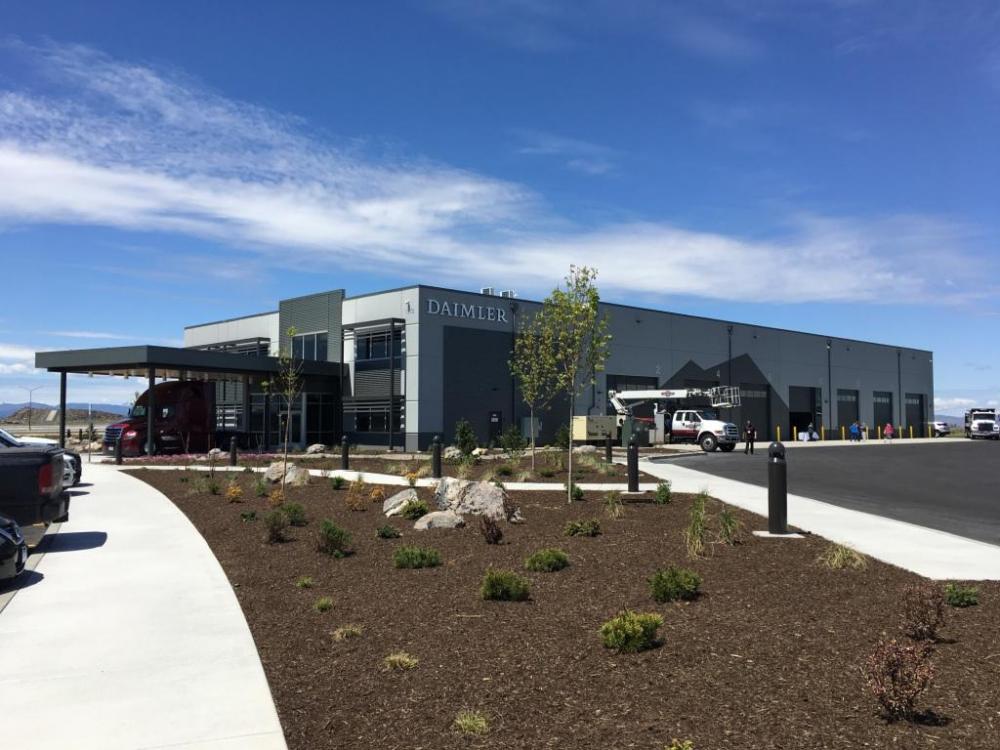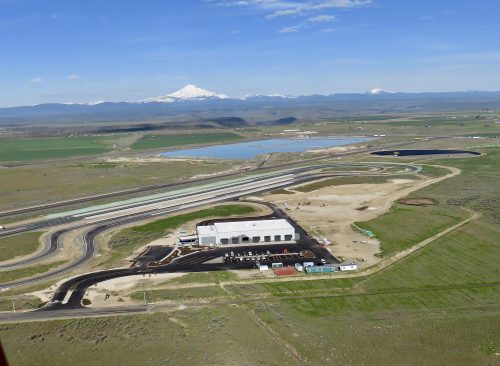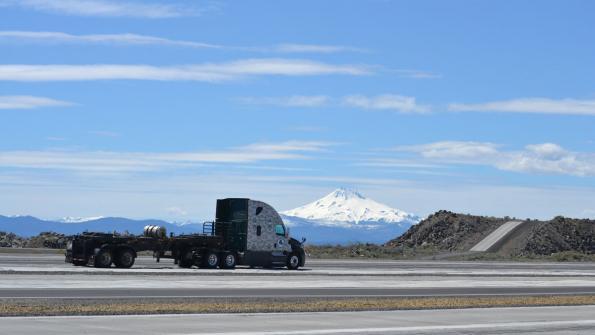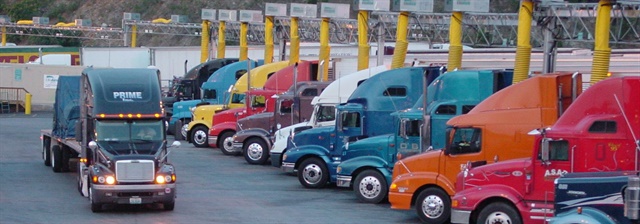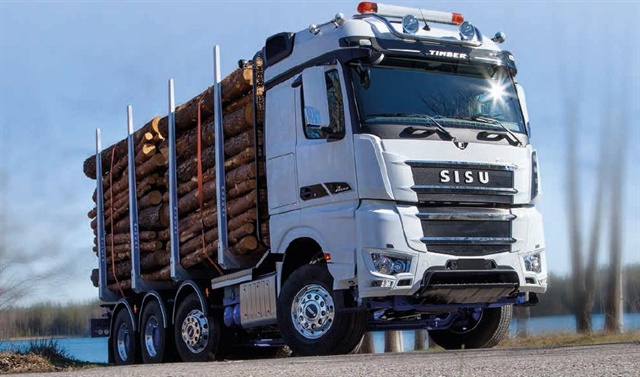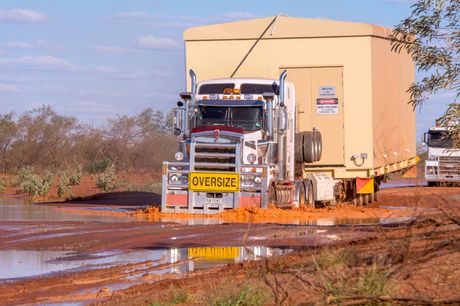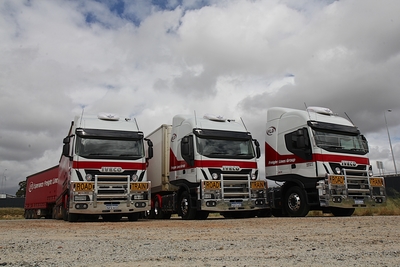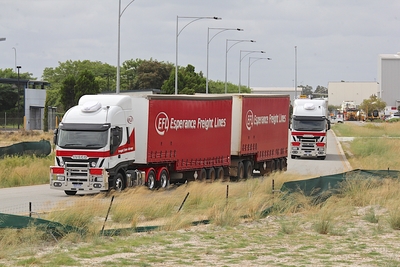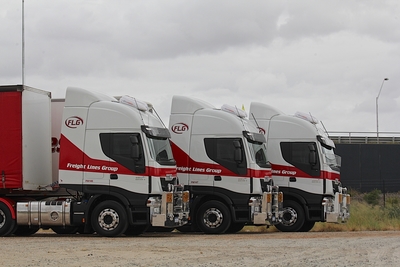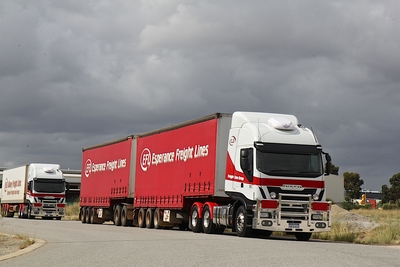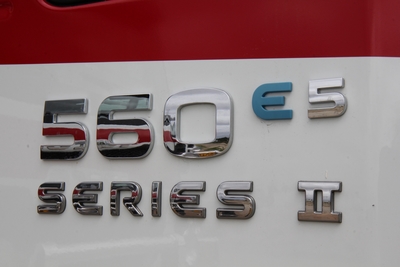
kscarbel2
Moderator-
Posts
17,893 -
Joined
-
Days Won
86
Content Type
Profiles
Forums
Gallery
Events
Blogs
BMT Wiki
Collections
Store
Everything posted by kscarbel2
-
Fleet Owner / May 19, 2017 MADRAS, OREGON. The new president and CEO of Daimler Trucks North America (DTNA) said he does not expect any shake-up of the North American Free Trade Agreement (NAFTA) or Phase 2 greenhouse gas rules. “I don’t anticipate any major changes in the NAFTA trade agreement,” said Roger Nielsen. “I think there are so many other discussions going on with government priorities right now, I don’t see this as coming up to the top of the list.” Nielsen made the comments during his first roundtable with reporters since being elevated from chief operating officer on April 1. He was in Madras to officially open DTNA’s new test track. President Trump previously threatened to withdraw from NAFTA, but more recently indicated a desire to renegotiate certain terms of the deal with Canada and Mexico. “We’re a global company,” said Nielsen. “We believe in free trade, and we’re prepared to engage anybody and everybody in discussions about what that means,” he said. Nielsen added that in the event there was a shift in trade policy, the company would be prepared. “If you take the worst case scenario and say there was a situation where we would be required to have 100 percent . . . assembled in America, we have the capacity to do it.” He added he is confident the company’s component suppliers would be ready as well. His message was similar when asked about the Phase 2 greenhouse gas regulations, with implementation scheduled to begin January 2018. He said cooperation between industry and Obama administration created a path over the next decade to not only reduce emissions, but make 10 miles per gallon in a diesel truck a regular occurrence. “We don’t see that changing. At the moment, there has been no discussions about changing it,” he said. Nielsen joined Freightliner, now DTNA’s parent company, in 1986, and has been COO since 2001. Though Nielsen has not regularly interacted with the media during his career, he was clearly at ease as he addressed a wide range of questions for more than 35 minutes. He said the Daimler leadership transition, starting with Wolfgang Bernard’s decision to resign as head of the global commercial vehicles unit earlier this year, was a “surprise.” He said Daum moving into that role “reflects the achievements we have been able to have here in North America.” Nielsen was “absolutely in shock” when Daum offered him the top position at DTNA, and humbly joked he is likely “to get credit for a lot of things Martin put in place.” As COO, Nielsen had regular interactions with maintenance executives. Now, as CEO, those discussions are more with the top decision makers of fleets that purchase Freightliner and Western Star trucks. That started with a 13-customer blitz in 13 different cities over five days, he said. Besides maintaining DTNA’s position as “the on-highway leader,” he said one goal is to become top seller in the vocational space. As for the current market, he reiterated DTNA’s earlier sales projection of 350,000 for Classes 6-8 for the NAFTA market this year. Incoming orders reflect a more equal mix between the largest fleets and smaller ones. Many of the large firms went on a buying spree over the past few years, bringing their average fleet age down. Nielsen said customers in the dry van sector are struggling to get rate increases from shippers due to intense competition. Combined with slipping prices on the used truck market, some fleets “not so eager to freshen up their trucks,” which may still be under warranty and running well. Customers waiting for the full range of next generation Cascadia models are also impacting current order intake, he suggested. Nielsen declined to respond when asked about Elon Musk’s suggestion Tesla will unveil a long haul electric Class 8 truck in September, other than saying “it is an interesting company to watch.” As for the overall electric truck market, he said there continues to be advances in electric battery power, and it likely makes sense for light-duty vehicles and short hauls. After declaring Daimler plans to be the leader in the electric commercial vehicles space, he questioned if the technology and related infrastructure will be ready in the near-term to allow long haul truckers, who try to avoid stopping, to experience “a drive like he does today, without energy insecurity.” .
-
Mack predicts Class 8 market will stay strong
kscarbel2 replied to kscarbel2's topic in Trucking News
Steady vocational market driving Mack’s growth James Menzies, Truck News / May 19, 2017 Mack’s market share reaches 10-year high as overall Class 8 demand shrinks In the first quarter of 2017, Mack Trucks reached its strongest share of the Class 8 truck market in more than a decade. It claimed 10.4% of the US market and 10.1% of the combined Canada/US market, improving on its previous 10-year high reached in the first quarter of 2016. The slowdown in Class 8 order activity over the past year has been most acute in the on-highway sleeper segment, while vocational truck sales have actually increased year-over-year, playing right into Mack’s hands. “I think, this past cycle has been all about the segments,” said Dennis Slagle, executive vice-president, Volvo Group, and president of Mack Trucks, when addressing trucking journalists at a Mack Trucks Born to Haul press event. “You had this loud correction in the long-haul sleeper segment of the market, day cab was also hit hard but not as hard, and vocational year-over-year has grown. The way we segment it, about 75% of the market is in contraction and the other 25% is quite good, and that kind of mix plays to Mack’s strength. We’ve enjoyed quite a bit of momentum, particularly during the first quarter.” Last year, the industry-wide challenge was to work through excess inventories. “Everybody in the industry, including Mack, has been successful in reducing that inventory down to a healthy level,” Slagle said. The high inventories dealers were saddled with last year meant the drop in Class 8 order activity didn’t reflect the true appetite for new trucks. “The market was there,” Slagle explained. “It wasn’t that people weren’t buying; it was good enough to get inventories down to safe levels…We’ve gone through that part of the cycle now, inventory industry-wide is at a good level, and we can start looking forward to factories building for the demand rather than factories building less because companies are trying to reduce inventories.” Last year’s market totaled 243,000 Class 8 trucks in North America, and Mack is projecting 215,000 for this year. But, Slagle added, “the underlying demand feels a bit healthier than it did last year.” Slagle said a business-friendly administration in Washington should drive stronger demand for new trucks. Jonathan Randall, senior vice-president, sales, Mack Trucks North America, said Mack’s strongest results in a decade came from maintaining its leadership position in the construction segment and growing its regional haul presence. The company is now looking to strengthen segments such as long-haul, where it’s not as prominent. It’s also a result of improving the service experience for customers, specifically through GuardDog Connect remote diagnostics, and the rollout of certified uptime centers. Randall said Mack now has 55,000 trucks connected through GuardDog Connect and 91 certified uptime centers, which implement processes to expedite repairs. Even small repairs used to take an average of four days to complete, but certified uptime centers have reduced that “dwell” time to two days. GuardDog Connect is about shifting from a reactive to proactive repair mindset, explained David Pardue, vice-president, connected vehicles and uptime services with Mack. The MackOneCallCenter analyzes fault codes and advises the operator on the best course of action. When the truck arrives at the dealer, it is pre-diagnosed with a repair plan in place so that it gets back on the road faster. Geofencing is used to track dwell time and Mack intervenes when dealers aren’t meeting expectations. The entire repair process is tracked through the ASIST online portal. “We’re seeing improvements in dealer efficiency,” Pardue said. “We can now measure it,” added Slagle. “What you can measure, you can manage.” Mack’s latest tool with which to improve uptime, is over-the-air engine software and parameter programming. The company is allowing fleets to receive software updates remotely without visiting the dealership, doing in approximately 30 minutes what would traditionally incur two days of downtime. This benefits both fleet managers and drivers, Pardue pointed out. But Slagle said Mack won’t be eliminating human interaction through the process. “When we start going full throttle with over-the-air, we will make sure there’s a human on the other end of the line to help if something doesn’t work, so we can talk it through and make sure their experience has been one of, I saved a couple days’ dwell time by being in my truck for 30 minutes,” he said. In addition to elevated levels of support, Mack also attributed an expanded and increasingly efficient product line to its success. Randall said the mDrive and mDrive HD automated manual transmissions have been hugely successful. Last year, they were spec’d in 20% of Mack Granites (37% this year, to date), 60% of Mack Pinnacle axle forward, and 80% of Mack Pinnacle axle back models. “The mDrive has been a game changer for us,” added John Walsh, vice-president, global marketing and brand management with Mack Trucks. “It’s great in terms of performance and the fuel efficiency it’s been able to deliver. The other thing is, the broadening of the driver pool. We hear from customers all the time, ‘We’d buy more trucks from you if we had more drivers.’ The mDrive expands that pool. The penetration on the highway side is approaching 90% right now.” The Mack LR cabover engine refuse truck is also performing well, Randall added, especially in Canada where it owns 75% of that segment. Tim Wrinkle, construction product manager, said Mack has also been successful convincing construction customers that today’s 13-liter engines can deliver all the torque and horsepower required to do a job that fleets traditionally thought could only be achieved by a 15-liter. The 13L MP8 [Volvo D13] provides up to 505 hp and 1,860 lb.-ft. of torque, comparing favorably to one 15L on the market that offers up to 505 hp and 1,850 lb.-ft., and rivaling another that comes in at up to 605 hp and 2,050 lb.-ft. “The 13-liter MP8 is able to deliver big block power and durability,” Wrinkle said. The durability comes from design attributes that include: a high-strength cast iron block, with bed plate for additional stiffness; 14-bolt flywheel-to-crank mounting (vs 12); more robust connecting rods, with greater bearing surface area compared to competitive 15Ls; and shorter piston travel, which results in less wear and friction on components. The wide-ranging discussion with Mack executives also touched on hot topics such as autonomous vehicles and alternative fuels. Slagle said Mack is keeping a close eye on the so-called “disrupters,” but doesn’t think autonomous trucks are close to taking over. “Any manufacturer in this business today has to have their heads up in terms of what is coming in terms of autonomous driving and different drivelines being kicked around and touted by some of the disrupters,” Slagle said. “Autonomous driving, I think it’s pretty clear we’re going to see various ventures into that on the automotive side. On the trucking side, I think the bigger you get, the more complex that will be.” Slagle said Mack will leverage whatever parent company Volvo Group develops, but added, “It’s something you have to approach very carefully if you have safety as one of your core values. At the right time, with the right partners, and with the right internal innovation, we certainly feel we can be competitive and on top of whatever is going on, maybe even leading it.” Walsh added autonomous trucks will likely first find a home in isolated environments, such as quarries and other job sites where interactions with other vehicles and humans are limited. As for all the buzz about electric trucks and other alternative fuels, Slagle said don’t rule out diesel yet. “The truth is, diesel remains a very formidable fuel,” he said. “It’s powerful. It’s now clean. It has an image problem, but with 3.5 million diesel vehicles out there and 60,000 diesel stations, it’s going to be with us for a while.” Mack still sees promise in dimethyl ether (DME), which burns clean and eliminates the need for a diesel particulate filter. “We think, some day, it will have its day,” Slagle said of DME. -
Mack predicts Class 8 market will stay strong
kscarbel2 replied to kscarbel2's topic in Trucking News
Mack Trucks Sees Its AMTs Increasing Adoption in the Market Transport Topics / May 19, 2017 CHARLESTON, S.C. — As one part of its integrated powertrain strategy, Mack Trucks’ line of automated manual transmissions is seeing increasing adoption in the market, said executives with the heavy-duty truck maker. When Mack Trucks starting building trucks in 1907, it had “a completely proprietary powertrain and it took about 85 or 90 years for everybody else to catch up,” said Jonathan Randall, senior vice president of sales for Mack Trucks. “Now you see the rest of the industry kind of moving in the same direction with proprietary powertrains and drivetrains.” Mack Trucks was “really the original disruptors of the commercial industry because we were the first ones to have a fully proprietary drivetrain,” Randall said, but noting that’s a bit tongue-in-cheek. He spoke with TT during the truck maker’s “Born to Haul” press event May 18 that included a tour of the Port of Charleston. Mack, one of North America’s largest manufacturers of heavy-duty Class 8 trucks, engines and transmissions, is part of the Sweden-based Volvo Group. Roy Horton, director of product strategy, said that for Mack Trucks, an integrated powertrain is the engine, transmission, driveline and rear axles, as well as the exhaust aftertreatment system. “It’s the configuration of those main components and how we optimize the performance and tailor the trucks for each of our customers’ applications,” Horton said. As for its automated manual transmissions, Horton said the mDrive and mDrive HD have been a success “out of the gate.” The adoption rate year-over-year has increased in each model it has been offered in, he said, noting Mack Trucks has offered the mDrive in its highway model since 2010, and started offering it in its Granite vocational model in 2015. The mDrive HD is an upgraded version of Mack’s 12-speed mDrive in its highway model, Horton said. “We upgraded it to make sure it could handle the vocational applications,” Horton said, noting the mDrive HD adds 13 and 14 speeds to offer slow speed “maneuverability” and “startability” that are needed for heavy haul applications. Horton said there are some “cowboy-type” drivers who want to stick with trucks that have manual transmissions. However, once they drive with an mDrive, they really like them, Horton said, pointing out that mDrive automated manual transmissions help reduce driver fatigue. At the end of a long week, there’s much less stress for the driver because they’re focused on driving and not shifting — “not having to push a clutch hundreds of times a day,” Randall added. As for sales trends, Mack Trucks ended 2016 at an 8.9% market share in the United States and Canada, and ended the first quarter with a 10.1% market share, Randall said. The company continues to see the most traction in the construction and vocational markets, he said, noting this includes its dump trucks, cement mixers and water trucks, among others. “We’re seeing a lot of activity and a lot of opportunity for growth,” Randall said. Another segment in which Mack sees a lot of opportunity is in regional haul and day cab, Randall said. “It’s continuing to be a larger portion, or a larger piece of the overall pie of the entire truck market.” At the event, Pat Barber, president and CEO of Superior Transportation, a South Carolina-based heavy haul trucking company, and Tracy Gunter Jr. and his son Tracy Gunter III of Tracy’s Logging, a South Carolina-based logging business, were on hand to tout the durability and other benefits of Mack Trucks. Tracy’s Logging has Mack Granite model tractors in its fleet, while Superior has various Mack Pinnacle models. Randall noted that over the past two years, the Class 8 over-the-road and long-haul truck segments have seen declines industrywide. In “a normal market,” the on-highway segment accounts for about 50% of the total volume of Class 8 truck purchases, he said. “We participate but not to the ... level we want to, and so we are making product enhancements and product improvements to be seen down the road that make us more of a consideration in that market,” Randall said. Turning to the regulatory environment, particularly future greenhouse gas regulations, one of the easiest ways to reduce emissions is to reduce fuel consumption, Randall said, noting they’re a “difficult proposition for all OEMs.” For Mack Trucks, the plan is in place and it’s moving forward to make sure it will meet the standards and the economic benefits for its customer base, he said. -
Sean Kilcarr, Fleet Owner / May 18, 2017 The OEM’s executives also believe that “underlying demand” is far healthier than 2016, which should lead to a ramp up in production. CHARLESTON, SOUTH CAROLINA. While Mack Trucks expects total Class 8 production volume will reach 215,000 units for 2017 – mirroring projections by other industry analysts – the OEM also believes that “underlying demand” for heavy trucks is stronger than many think, meaning that the market should exit 2017 stronger than when it entered the year, with manufacturers ramping up to build more equipment as time goes on. “The market is good,” explained Dennis Slagle, Mack’s president and executive vice president with its parent company, the Volvo Group. “We’ve come out of a long correction in the long-haul sleeper and daycab segments, while vocational sales continued to do well. That played to Mack’s strengths so we had a good first quarter this year.” High inventory levels were one reason for that “correction,” he said, with virtually all of it comprised of on-highway Class 8 trucks. But inventory peaked in October 2015 and has now been reduced to what Slagle called “a healthy level” and that OEMs have now positioned their factories to build to customer demand. “We’re looking at some sort of ramp [up] to adjust to market conditions,” he emphasized. “Underlying demand is healthier than last year. We also think the business-friendly environment of the Trump administration will help if he gets through the mismanagement of the [federal] bureaucracy and gets back on track to focusing on the economy.” Jonathan Randall, Mack’s senior vice president of sales, added that Mack grew its market share in every one of its segments last year – on-highway, regional, vocational, etc. – for a total gain of about one percentage point, which, “by all accounts is putting Mack on a roll.” He noted that the OEM plans to expand on its “growing foothold” in the long-haul market with a product announcement slated for later this year, alongside plans to keep growing its regional business while maintaining its position in the vocational segment. “We see the same [growth] trends we experienced last year occurring this year,” Randall pointed out. Part of that growth trend includes faster adoption of [Volvo I-Shift] Mack’s proprietary mDrive automated mechanical transmission (AMT), stressed Roy Horton, Mack’s director of product strategy. He said the mDrive is being spec’d in 80% of the OEM’s Pinnacle axle back highway models, 60% of its Pinnacle axle forward models, and 20% of its Granite conventional trucks – with Randall noting that the backlog for mDrive gearboxes spec’d in Granite vocational models is now at 30% for 2017. Overall, Horton said AMTs and fully-automatic transmissions are now being spec’d across 80% or more of all Mack’s models, with only 15% to 20% of orders requesting manual transmissions. “We sell more Eaton manual transmissions on the highway side of our business, while our proprietary Maxitorque [manual] is the predominate selection on the vocational side,” he added. Other trends Mack touched on during its Charleston conference included: Slagle believes demand for trucks that run on liquid natural gas or LNG “is dying” while demand for compressed natural gas or CNG-powered trucks “is staying pretty steady.” While that is promising, he added that diesel remains a “foundational fuel” as it is powerful, clean, and fuels 3.5 million vehicles in the U.S. served by 60,000 filling stations across the country. “Diesel is going to be with us for a while,” he stressed. Horton noted that demand for engine displacements greater than 13 liters is declining rapidly across the Class 8 segment. In 2009, he said, 56% of Class 8 trucks had engines with displacements greater than 13 liters; by 2016 that dropped to 40%. John Walsh, Mack’s vice president of global marketing and brand management, noted that the difficulty of finding drivers remains an “underlying theme” among the OEMs customers. “The hard part is putting into numbers just how many more trucks the industry would sell if it had enough drivers,” he said. Randall noted that OEMs remain supportive of Phase 2 greenhouse gas (GHG) rules and that Mack will not change its GHG-based product plans going forward. “They will help us meet customer demand for more fuel economy,” he explained. However, Slagle stressed that it remains “very challenging” to get Class 8 trucks to meet the GHG standards. “Make no mistake, this is costing a lot of money and the end user must embrace that as well,” he pointed out. David Pardue, Mack’s vice president for connected vehicles and uptime services, said more than 55,000 Mack trucks are now on the road equipped with the OEM’s GuardDog Connect telematics system. Even legacy models can now be upgraded with a similar telematics function via its new partnership with Geotab. Pardue added that 91 dealers now certified as “uptime centers.” At those locations, repair diagnostic times are down an average of 70%, repair times in total are down 21%, shop efficiency is up 24% and “check in” time for repairs is down by over 40 minutes. .
-
Daimler opens new proving grounds Truck News / May 19, 2017 MADRAS, Oregon – Daimler Trucks North America (DTNA) has officially opened its Oregon-based High Desert Proving Grounds. DTNA invited trucking journalists across North America, as well as local dignitaries and local press to attend the grand opening event on May 18 to mark the occasion. The grand opening featured speeches from DTNA executives, full facility tours, and a ride and drives on the newly paved 3.5-mile test track. The grounds, which required an $18.7 million investment by the company, encompass 87 acres in total. It comes complete a test track, a brand new 32,000 sq-ft office building that will soon be home to about 40 employees, and a sizable workshop with 14 service bays for technicians to work in. There’s also a driver lounge and conference rooms with large picture windows for all employees to enjoy the mountainous view. According to Roger Nielsen, DTNA’s newly-appointed president and CEO, the proving grounds were built to serve a two-fold function. The first, to solidify and validate DTNA as North America’s undisputed market leader and become a louder player in the realm of research and development. The second, to bring innovative technology to the market faster than before. “We’re excited to be a more predominate player in the testing of durability, reliability of our brand and brands around the world,” Nielsen said at the grand opening. “Putting our investment here is one more piece of the foundation we’re putting together to solidify our place as the North American leader. For sure you’re going to see…trucks platooned and paired up here, you’re going to see autonomous vehicles driving up here. It’s truly a place for us to bring product to market faster and quicker and honestly, with higher quality.” Wilfried Achenbach, senior vice-president of engineering at DTNA said that Madras was specifically chosen as the place for the proving grounds because of its proximity to Portland, Ore. where the company’s year-old new headquarters is situated. The drive between the headquarters and the proving grounds about 120 miles, which allows the engineering team to travel by car to access the testing facility. “It will save us time, and bring our engineers closer to the product,” said Achenbach. “Together with our full-scale wind tunnel other state of the art engineering test facilities in Portland, the proving grounds will help us stay ahead of the competition.” In addition, the 120-mile drive is helping the company out even more as the route provides vehicles real world validation by including portions on the interstate, rural roads, and mountainous terrain through the Mount Hood pass. The route itself has been used to validate potential gains of truck platooning, one technology that DTNA is exploring for the future. Achenbach added that the new test track is similar to those Daimler has in Germany and soon in Brazil. The track’s surfaces, which are highly engineered, will help DTNA determine a truck’s full service life in just six months. “This is a great day for Madras. Having Daimler Truck North America invest in our city is a testament of a long partnership,” said Royce Embanks, Mayor of Madras. “Daimler Trucks North America has a long history with the City of Madras and the partnership has been a win-win for both parties..We look forward to the future and supporting the undisputed market leader in the commercial vehicle industry.” .
-
Daimler opens Oregon truck proving grounds Commercial Carrier Journal / May 18, 2017 Daimler Trucks North America (DTNA) on Thursday opened its new High Desert Proving Grounds in Madras, Oregon. Built in just more than 13 months, the $18.7 million research and development facility sits on 87 acres next to the city airport and includes a 3.5-mile test-track loop and 32,000 square feet building. The track represents part of a more than $170 million investment in the State of Oregon, including Daimler’s new Portland headquarters about 120 miles north. Roger Nielsen, Daimler Trucks North America president and CEO, says the company will use the proving grounds to validate truck designs as well as test connected vehicles, platooning, and autonomous trucks and technology. “It is truly a place to bring products to the market faster,” he says. Madras has been home to a smaller Daimler test track for more than 30 years, and DTNA Senior Vice President of Engineering and Technology, Dr. Wilfried Achenbach says Madras was selected for expansion due to its proximity to Portland, making it easier to get engineers involved in the design validation process. “It will save us time, and bring our engineers closer to the product, and allow us to engineer a better truck,” he says. Previously, Daimler primarily tested its trucks in New Carlisle, Ind. The route from Portland to Madras also provides vehicles real world validation by including portions on the interstate, rural roads, and mountainous terrain through the Mount Hood pass. Most recently the route has been used to validate potential gains of truck platooning, just one technology that DTNA is exploring for the future benefit of our long-haul fleet customers. The Madras track is similar in design to Daimler tracks in Germany and soon in Brazil, which Achenbach says will allow engineers to share data across the company’s global network. The track’s design, thanks in part to its varying engineered surfaces, allows the company to accelerate its road testing. Achenbach says 6,000 miles around the truck represents 1.2 million miles on-highway, allowing engineers to simulate a typical vehicle’s full service life in approximately six months.
-
Company says test track will speed develop of new products, technology MADRAS, OREGON. Daimler Trucks North America (DTNA) officially opened its new test facility here May 18, which the company said will speed the development of new vehicles and deployment of advanced technologies. Known as the High Desert Proving Grounds, the facility is 120 miles from DTNA’s headquarters in Portland, OR. It took one year to construct and represents a major expansion of a limited-use facility the company has maintained for more than 30 years. Previously, DTNA utilized a shared facility in Indiana, a lengthy travel commitment from its Pacific Northwest home. “This is truly a place for us to bring products faster, quicker . . . and better than our competitors can ever do,” said Roger Nielsen, president and CEO of Daimler Trucks North America. The opening was Nielsen’s first media event since taking over for Martin Daum on April 1. Daum was elevated to president of Daimler’s global commercial vehicles unit following the departure of Wolfgang Bernhard. “This is an engineering dream,” said Wilfried Achenbach, DTNA’s senior vice president of engineering and technology. He said the short drive from the company’s headquarters will allow engineers “to come here to modify software and get into the truck and try it out,” all in one day. In an interview with Fleet Owner, he said the distance between Oregon and the test facility in Indiana created a disconnect making it hard to keep engineering teams engaged. The new facility also eliminates the need to spend several days moving test vehicles long distances. DTNA said it invested $18.7 million into the 87-acre facility, which will house about 40 full-time engineers, technicians and truck drivers, apart from existing employees based at other locations. Last year, it opened a new $150 million headquarters in Portland. The test track in Madras is 3.5 miles of engineered surfaces, allowing DTNA to simulate a typical vehicle’s full service life in about six months. The track features nine concrete test events comprised of 379 precast panels. “This replicates any road surface you can find around the world,” Achenbach said. DTNA said the facility will improve the durability and fuel economy of its vehicles, while also more rapidly advancing platooning and autonomous technologies. Daimler has a similar test facility in Germany, and is constructing one in Brazil. “Bumps are bumps, wherever you go,” Achenbach said in explaining the company’s plans to share test results between the locations. Achenbach also noted Madras’s climate – hot in the summer and cold (but not too cold) in winter – makes it an ideal location for testing. Additionally, the route from Portland to Madras also provides real world validation by including portions on the interstate, rural roads and mountainous terrain through the Mount Hood pass. Photo gallery - http://fleetowner.com/equipment/shake-rattle-roll-tour-daimlers-hdpg
-
Heavy Duty Trucking / May 19, 2017 A Duke Energy project to fund electrification at a N.C. truck stop is projected to save 25,000 gallons of truck fuel annually. Big Boy's Truck Stop in the town of Kenly, will soon have 24 truck electrification stations where drivers can pay to plug in their vehicles, offering an economical way to provide electricity and hot or cold air during overnight stays that avoids idling engines. Additionally, four plugs will provide standby power for refrigerated cargo to avoid the need to run diesel compressors. On an annual basis, the project should reduce carbon dioxide emissions by almost 500 tons and reduce volatile organic compounds (VOCs) and nitrogen oxide (NOx) emissions by more than 2 tons. Duke Energy will spend $300,000 on the project. The plug-in stations are expected to be installed before this summer. IdleAir, located in Knoxville, Tenn., will be tasked with installation and maintenance. "This is a common sense feature that helps truckers get a cleaner, quieter night's sleep, while saving them money and sparing the community from significant emissions," said Mark Miller, president of Convoy Solutions, provider of IdleAir, in a statement. Each year, more than 2 billion gallons of diesel are wasted by overnight idling, according to a study from Argonne National Labs. Idling is the industry standard method of providing overnight comfort to the more than 1 million drivers who sleep in their trucks each night. This program was part of a 2015 settlement between Duke Energy and the U.S. Environmental Protection Agency and environmental groups after allegations that some of the utility's coal-fired plants violated the Clean Air Act. .
-
Heavy Duty Trucking / May 19, 2017 Finland is not usually associated with being a hotbed of cutting-edge automotive design. But Europe is leading the charge on a wide range of new transportation technologies. And the Finns are certainly playing their part in the tech wave sweeping trucking today. Two Finnish companies, Sisu and Visedo, have developed a hybrid-electric parallel power system they say produces 1,140 horsepower and 3,687 lbs.-ft. of torque. Sisu is a Finnish truck manufacturer. Visedo is a Finnish manufacturer of heavy-duty hybrid and electric power systems that says it developed the electric power system as a proof-of-concept vehicle that integrates the parallel hybrid drive, which draws power from both an electric motor and a diesel engine connected via the same axle. The new system is designed to work with Mercedes-Benz OM471 and OM473 diesel engines. Diesel is the primary power source, with the electric motor kicking in during peak energy demand periods. When needed, auxiliary power is delivered by a Visedo permanent-magnet electric motor, while the mechanical powertrain is controlled by a Visedo inverter and PowerBoost DC-DC converter. Excess energy is stored in a supercapacitor, with the entire system designed to be customizable with simple vehicle integration to meet customer needs. Additional power and charging requirements are initiated automatically, allowing the driver to concentrate on the road, although an in-cab monitor allows the driver to track of the system’s functions and take control of it if needed. The main objective for Visedo and Sisu was to reduce fuel consumption and reduce emissions, the companies said. However, they noted that the hybrid system also boosts available low-speed torque for heavy duty trucks and also enables the use of the vehicle with or without electric power since the drive line is mechanically continuous from the diesel engine to the axle. The companies unveiled the new drive system launched at this year’s Kuljetus transport tradeshow in Finland, saying it marks an important milestone for hybrid electric power to deliver fuel savings and emissions reductions in the heavy road transport sector. “We’re proud to be giving Europe its first look at such a breakthrough hybrid truck drive system that’s capable of delivering breakthrough power and performance while saving fuel and reducing emissions,” said Risto Tiainen, Visedo system solutions manager. “The revolution to electrify the world’s diesel transport is already underway. After delivering pioneering hybrid and electric power for passenger buses, Visedo is proud to be powering the next generation of cleaner truck transport solutions.” .
-
“I just fired the head of the FBI. He was crazy, a real nut job,” President Trump said in his meeting with Russian officials last week. “I faced great pressure because of Russia. That’s taken off.” . .
-
A Williams air valve? No longer available?
-
Reuters / May 18, 2017 DETROIT -- General Motors plans to quit selling vehicles in India by the end of this year and will sell operations in South Africa, the latest steps in a strategy of focusing cash and engineering effort on fewer, more profitable markets. GM said on Thursday it will take a $500 million charge in the second quarter to restructure operations in India, Africa and Singapore. It will cancel most of a planned $1 billion investment to build a new line of low-cost vehicles in India. About $200 million of the charge will be a cash expense, GM said. The moves are expected to save $100 million a year in a sector of GM's global business that last year lost about $800 million, the company said. GM President Dan Ammann told Reuters in an interview that the latest restructuring moves -- and a series of earlier decisions to quit unprofitable markets -- allow GM to focus more money, engineering effort and senior management time on expanding where the company is strong, including China and the North American pickup and SUV business, where GM has a "product onslaught coming." GM also has said it is investing about $600 million a year to develop autonomous vehicles and transportation services. "What are we spending our time doing?" Ammann said. "Are we spending time pursuing opportunities or all of our time fixing problems?" GM, like its Detroit rival Ford Motor Co., has found it increasingly expensive to compete in emerging markets outside of China. GM sold just 49,000 vehicles in India and South Africa combined last year. CEO Mary Barra traveled to New Delhi in 2015 to announce a plan to invest $1 billion there to build a new line of Chevrolet models developed as part of a Global Emerging Market vehicle program - GEM for short. Since then, auto sales overall in India have slumped, and GM has failed to gain traction against incumbents such as Maruti Suzuki India. Now, GM plans to stop selling Chevrolet brand vehicles by the end of the year and will produce vehicles only for export at its remaining factory in Talegaon, 75 miles east of Mumbai. The company currently employs about 2,500 workers there. GM said it would continue work at its design and engineering center near Bangalore. The $5 billion GEM program, which GM is developing with its Chinese partner Shanghai Automotive Industries Corp, remains on track to account for about 2 million vehicles a year in global sales volume, mainly in Latin America, Mexico and China, Ammann said. "The market opportunity for GEM has continued to grow," he said. South Africa operations In a separate move, GM plans to stop building Chevrolet vehicles in South Africa and sell its South African factory to Japan's Isuzu Motors, along with the 30 percent stake the U.S. automaker owns in a truck venture with Isuzu Motors. Isuzu agreed in February to buy out GM's 57.7 percent stake in a joint venture in Kenya. GM also will cut an undisclosed number of staff at its GM International Operations headquarters in Singapore. About 200 people work in that operation, the company said. Since Barra took over GM in 2014, the one-time largest automaker in the world has taken aggressive steps to narrow its focus to China, the highly-profitable North American light truck and SUV market, Latin America, vehicle financing and transportation services that ultimately could use autonomous vehicles. Despite the restructuring moves, including Barra's decision in March to sell money losing European operations to France's PSA Group, GM's share price has been stuck in a range close around $33 where it went public in 2010 following a government-funded bankruptcy. GM shares closed on Wednesday at $32.42. Barra and GM's directors are under pressure from David Einhorn's Greenlight Capital, which wants GM to split its common stock into two classes, one that pays dividends and a second that would be valued to reflect the company's potential growth. Greenlight also has put forward a slate of three new directors. GM's management and incumbent board have rejected Greenlight's proposals. The hedge fund holds 54.8 million GM shares, or about 3.5 percent of the total.
-
Big Rigs / May 16, 2017 OUTBACK Truckers is back and bigger than ever with the launch of season 5 tonight, with episode 1 set in the Kimberly. The 13 episode season welcomes back both a few regulars along with some new faces. Making a return is family man Yogi, 'Outback Legend' and Steve Grahame after last year surviving a tyre blow out that put him in hospital. "We are happy to see a few of our favourites back, especially Steve after his shoulder operation who is back on the road after four months," joint managing director of Prospero Productions Julia Redwood said. Now in the post production stage for the final episodes Julia said the team is excited to reveal season 5 to it's Australian audiences tonight. "What I love about this series is we show the real deal epic journeys these drivers take on, it's very exciting and these drivers deserve recognition for the conditions they have to work through," Julia said. "We see new faces and head on different journeys to places like Tasmania to the fish markets in Melbourne and an extraordinary journey to Micronesia," she said. While many fans of the show come from the industry, Julia says the reactions she gets from those who have had no experience in trucking are often of amazement. "We hear feedback where people are blown away with what drivers in Australia have to deal with, they say wow I didn't know this world existed," Julie said. "Some of the media surrounding the trucking industry isn't always the best so we aim to show the industry in it's real and positive light. "A majority of drivers are really hard working, dealing with difficult and sometime risky situations while they are under a lot of pressure to achieve. During the filming a crew of 3-4 people travel with the drivers for the whole journey, capturing every moment. "This is the real Australian voice we are capturing, the story of the drivers that keep the country running," Julie said. .
-
PACCAR keen to show off DAF and Kenworth ranges Big Rigs / May 17, 2017 ATTENDEES at this year's Brisbane Truck Show will find an exciting selection of 11 world-class DAF and Kenworth trucks on the 'PACCAR World' stand. The stand is designed to provide patrons with an all-access experience to PACCAR Australia's class-leading range of brands and trucking solutions. PACCAR Australia's Director Sales and Marketing, Brad May, says the Brisbane Truck show offers those in transportation the ideal forum to congregate and experience the best developments and innovation the industry has to offer. "PACCAR World will have on display a range of advances, including from DAF the official launch of the DAF CF85 with 510Hp and the display of the new FAP LF 280, touted for release later in 2017," Mr May said. "For Kenworth, the show is all about the revolutionary T610 and T610SAR. Launched little more than five months ago, the new model is certainly living up to its billing as, 'Our Best Truck Yet'. We are delighted with the market's response due to its versatility, space and safety features, and the T610 and two T610SARs on display are certain to draw in everyone to have a look." "Complementing our two truck brands will be the full range of PACCAR Australia products and services. We will have professionals from most areas of our business, including production, engineering and sales, as well as dealer representatives from across Australia on hand to explain how PACCAR Australia offers the complete solution for fleets, operators and drivers," May said.
-
Iveco Trucks Australia / May 17, 2017 When hauling perishable goods, reliability is a key consideration according to Freight Lines Group Managing Director, Michael Harding. To help service a contract with Australian supermarket giant, Woolworths, Freight Lines Group recently added three Iveco Stralis AS-L Series II prime movers to the fleet, with another three vehicles to shortly join them. Michael should know a thing or two about the industry, having grown the WA-based transport business markedly since assuming ownership in 2008, transforming the organisation into one of the state’s top-10 road freight and logistics companies, employing over 190 staff and running a fleet of over 100 prime movers. As well as this recent history, Michael’s involvement with the company goes back much further, with his farther John, actually establishing the business in the 60s as ‘Esperance Freight Lines’, to take advantage of Esperance’s prosperity as a growing agricultural hub. “When you’re transporting food stuff, it all needs to be at the stores at a certain time, you can’t afford to be late or to have problems with breakdowns,” he said. “We operate the new Iveco Stralis models on this contract and so far they haven’t missed a beat.” The three Stralis AS-Ls run Pantech road train trailers between Perth and Albany return six days per week – over the course of the six days, they cover over 5,000 kilometres. Each truck now shows a trouble-free 200,000 plus kilometres on the odometer. The vehicles feature a Series II Cursor 13 engine producing 560 horsepower and 2300 Nm of torque, and as an added bonus, the engine is covered by market leading warranty package of five years or 1,000,000 kilometres. Coupled to the power plant is Iveco’s 16-speed Eurotronic II automated transmission, providing a relaxed driving experience while allowing the driver to select from automatic or manual shift control if required. On the safety front, the trucks feature front and rear disc brakes with ABS, EBL (Electronic Brake force Limitation) and ASR (Anti-Slip Regulator). The vehicles are finished in the Freight Lines Group’s red highlight livery and are fitted with bullbar and auxiliary forward lighting for increased safety. According to Michael, the strong performance of the first three Stralis AS-L units prompted him to place a second order. “The first ones are doing very well,” Michael said. “My time behind the wheel has been limited to moving them around the yard but the drivers are certainly happy with them and that’s an important factor. “Feedback is that they’re a comfortable truck and the power and torque is a good fit for the application – the trucks are usually running at around 40 tonne net payload and they do this easily. “The Stralis models had the right specification plus provided good value for money compared to some of the other prime movers out there. And while not the main factor in the purchase decision, the fact that they’re developed and manufactured in Australia was also noted.” The new Stralis prime movers will stay on fleet for around five years in keeping with their operating lease timeframes, a service also provided by Iveco through in-house financier CNH Industrial Capital. .
-
Freightliner racing brings trick Coronado onboard
kscarbel2 replied to kscarbel2's topic in Trucking News
-
-
Isuzu Truck Customers: Garden Grove - Diesel, Dust & Gigas
kscarbel2 posted a topic in Trucking News
Isuzu Australia / May 15, 2017 Garden Grove is a multi-faceted business, offering garden supplies, bulk haulage and even a construction company. This versatility requires them to maintain an extensive transport fleet in which Isuzu Trucks, with its seemingly endless flexibility across every weight segment, plays a starring role. . -
NTI restores International truck to raise funds for charity
kscarbel2 replied to kscarbel2's topic in Trucking News
Bringing Back To Life Diesel News Australia / May 17, 2017 A new initiative from National Transport Insurance (NTI) will see the insurance company bringing back to life a truck to be auctioned to raise funds for and awareness of Motor Neuron Disease (MND). It has announced a new initiative bringing together members of the transport industry and community to support the MND and Me Foundation in raising much-needed funds for Motor Neurone Disease. Over the coming months, NTI will restore a 1946 International Model K5 rigid truck, which will be raffled for the MND and Me Foundation to help people living with the disease. “The restored, operational truck will be a culmination of time, energy, skill and resources generously contributed by NTI’s people, suppliers, partners and industry affiliates”, said NTI CEO Tony Clark. “It’s a truck built for the community, by the community. It will bring people together and tell a story, while serving a much greater purpose.” The entire journey will be documented and shared online via a series of webisodes, across NTI’s social media platforms. The truck will be on display in its current state at the 2017 Brisbane Truck Show, where visitors can purchase raffle tickets on the day. Tickets will also be available online following the event, until September. “The MND and Me Foundation is honoured to be involved in this very exciting project,” said Paul Olds, MND and Me Foundation CEO. “NTI’s efforts will generate better awareness of the impact that Motor Neurone Disease has on the community, and raise vital funds to ensure no one faces MND alone.” -
Nikola CEO compares truck OEMs to failed photo company Prime Mover Magazine / May 17, 2017 Nikola CEO, Trevor Milton, has reportedly suggested that today’s truck manufacturers could face the same fate as US company Kodak, whose film business collapsed during the advent of digital cameras. According to US news service, truckinginfo.com, Milton used the 66th annual meeting of the Quebec Trucking Association as a stage to point out that traditional truck OEMs are at risk of making the same mistake as Kodak. “[Kodak] was so powerful that it never expected to change anything,” he explained. “Why change something that already works?” One of Kodak’s main mistakes was that it focused solely on an existing product without considering a changing environment, he said at the event. "In the event of a war, for example, the litre of diesel could reach five or seven dollars ... You'll never have to pay that kind of money to run the Nikola One." According to truckinginfo.com, Milton also compared the truck’s sales strategy – which will be based on monthly payments that include the price of the truck as well as fuel, maintenance, insurance – to Apple’s highly disruptive iTunes concept. "The other companies took a long time to figure out what was happening, and that's what's going to happen with the trucking industry," he said. Milton also confirmed the Nikola product would on the road by 2021. “It's not a dream," he was quoted as saying. "The future is here and we're all going to be part of it.”
-
NTI restores International truck to raise funds for charity
kscarbel2 replied to kscarbel2's topic in Trucking News
NTI charity resto: Old Inter K5 a go-er Owner/Driver / May 17, 2017 National Transport Insurance (NTI) is restoring a 1946 International Model K5 to raise money and support for Motor Neurone Disease. The restoration process, which NTI says will be built for the community, by the community, is being documented in a series of online videos. In order to tackle the project, NTI says it will call on suppliers, partners and industry affiliates to offer their knowledge, time and resources. Green Diamond, as the Inter has been appropriately dubbed, will be raffled upon completion and all of the proceeds will be donated to the MND & Me Foundation. "We went to our people, told them the story and they agreed MND would become our primary charity," NTI CEO Tony Clark says on the restoration project website. "With our DNA and background in transport we felt the restoration of a truck would let people follow the journey, enjoy it, but then raffle the truck for a great cause – Motor Neuron Disease." -
Australasian Transport News (ATN) / May 17, 2017 All proceeds from the Green Diamond raffle will be donated to the MND & Me Foundation National Transport Insurance (NTI) is restoring a 1946 International Model K5 to raise money and support for motor neurone disease (MND). The resotration process, which NTI says will be built for the community, by the community, is being documented in a series of online videos. In order to tackle the project, NTI says it will call on suppliers, partners and industry affiliates to offer their knowledge, time and resources. Green Diamond, as the Inter has been appropriately dubbed, will be raffled upon completion and all of the proceeds will be donated to the MND & Me Foundation. "We went to our people, told them the story and they agreed MND would become our primary charity," NTI CEO Tony Clark says on the restoration project website. "With our DNA and background in transport we felt the restoration of a truck would let people follow the journey, enjoy it, but then raffle the truck for a great cause – Motor Neuron Disease." .
-
Volvo Tests Self-Driving Refuse Truck in Urban Environment
kscarbel2 replied to kscarbel2's topic in Trucking News
Volvo Trucks and Renova testing autonomous refuse trucks; driving in reverse Green Car Congress / May 17, 2017 Swedish waste management company Renova and Volvo Trucks are currently testing and researching how automated vehicles can contribute to safer, more efficient refuse handling and create a better working environment for drivers. The automated systems being tested are in principle the same as those fitted to the autonomous Volvo truck operating in the Kristineberg Mine in northern Sweden since autumn 2016. The refuse truck relies on a GPS and LiDAR-based system for mapping, positioning and scanning of the area around the vehicle. The autonomous system controls steering, gear changing and speed. The vehicle stops automatically if an obstacle on the road suddenly appears. Driving a heavy commercial vehicle in an urban residential area with narrow streets and vulnerable road users naturally imposes major demands on safety, even when the vehicle's speed doesn't exceed a normal walking pace. The refuse truck we are now testing continuously monitors its surroundings and immediately stops if an obstacle suddenly appears on the road. At the same time, the automated system creates better prerequisites for the driver to keep a watchful eye on everything that happens near the truck. —Carl Johan Almqvist, Traffic & Product Safety Director,Volvo Trucks The first time the automated refuse truck is used in a new area, it is driven manually while the on-board system constantly monitors and maps the route with the help of sensors and GPS technology. The next time the truck enters the same area, it knows exactly which route to follow and at which bins it has to stop. At the first stop with the automated system activated, the driver climbs out of the cab, goes to the rear of the truck, brings out the wheelie-bin and empties it exactly the way the job is done today by operating the relevant controls. When the operation is completed, the truck automatically reverses to the next bin upon receiving the driver’s command. The driver walks the very same route that the truck takes and thus always has full view of what’s happening in the direction of travel. By reversing the truck, the driver can constantly remain close to the compactor unit instead of having to repeatedly walk between the rear and the cab every time the truck is on the move. And since the driver doesn’t have to climb in and out of the cab at every start and stop, there’s less risk of work related injuries such as strain on the knees and other joints. —Hans Zachrisson, Strategic Development Manager at Renova Reversing is otherwise a fairly risky maneuver since the driver may find it difficult to see who or what is moving behind the vehicle, even if it is fitted with a camera. In certain areas it is not allowed to reverse with a heavy commercial vehicle for safety reasons, in others it is a requirement that a co-driver must stand behind the truck to ensure that the road is clear before the vehicle is allowed to reverse. The solution being tested is designed to eliminate these issues. Since sensors monitor the area all around the refuse truck, driving is equally safe no matter the direction in which the vehicle is moving. And if for instance the street is blocked by a parked car, the refuse truck can automatically drive around the obstruction provided there is sufficient space alongside. Since the automated systems optimize gear changes, steering and speed, fuel consumption and emissions can also be reduced. Although the technical scope already exists, much research, testing and development remains before self-driving refuse trucks can become a reality. The current joint project will continue until the end of 2017 and will be followed by an extremely thorough evaluation of functionality, safety and, not least, how well this type of vehicle is accepted by drivers, other road users and local residents. Vehicles with varying degrees of automation will probably be introduced earlier in other applications, where transport assignments take place within strictly confined areas such as mines and cargo terminals, the company said. -
Volvo Tests Self-Driving Refuse Truck in Urban Environment
kscarbel2 replied to kscarbel2's topic in Trucking News
Volvo pioneers autonomous, self-driving refuse truck in the urban environment Volvo Group / May 17, 2017 In the latest research and development in self-driving vehicles, Volvo Group, together with Swedish waste and recycling specialists Renova, is testing a pioneering autonomous refuse truck that has the potential to be used across the urban environment. The project explores how automation can contribute to enhanced traffic safety, improved working conditions and lower environmental impact. “There is amazing potential to transform the swift pace of technical developments in automation into practical benefits for customers and, more broadly, society in general. Our self-driving refuse truck is leading the way in this field globally, and one of several exciting autonomous innovations we are working with right now,” says Lars Stenqvist, Chief Technology Officer, Volvo Group. Volvo Group’s autonomous refuse truck is designed to make the driving safer in built-up areas, not least when reversing. Sensors continuously monitor the vehicle’s vicinity and the truck stops immediately if an obstacle suddenly appears in its path. The route is pre-programmed and the truck drives itself from one wheelie-bin to the next. The driver, who walks ahead of the reversing vehicle, can focus on refuse collection and does not have to climb into and out of the cab every time the truck moves to a new bin. “One important benefit of the new technology is a reduction in the risk of occupational injuries, such as wear in knee joints – otherwise a common ailment among staff working with refuse collection,” explains Lars Stenqvist. The autonomous truck also offers major environmental upsides. Gearchanging, steering and speed are constantly optimised for low fuel consumption and emissions. The joint project with Renova will continue until end of 2017. The autonomous truck currently being tested is fitted with a sensor system for identification, navigation, and monitoring of the vehicle’s vicinity. Most of this technology is also used in the autonomous truck for mining operations that Volvo Group unveiled in 2016. That self-driving truck is undergoing tests in the Kristineberg Mine in northern Sweden. Link to film: https://www.youtube.com/watch?v=zJSHXr8i-ZU Link to high-resolution images: http://images.volvogroup.com/ More information about Volvo Group’s work with autonomous vehicles can be found at www.volvogroup.com/automation . For more information please contact Volvo Group’s press department, Henry Sténson +46 31 323 72 29 .
BigMackTrucks.com
BigMackTrucks.com is a support forum for antique, classic and modern Mack Trucks! The forum is owned and maintained by Watt's Truck Center, Inc. an independent, full service Mack dealer. The forums are not affiliated with Mack Trucks, Inc.
Our Vendors and Advertisers
Thank you for your support!


